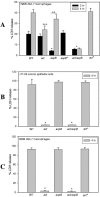The type III secretion system and cytotoxic enterotoxin alter the virulence of Aeromonas hydrophila
- PMID: 16177316
- PMCID: PMC1230953
- DOI: 10.1128/IAI.73.10.6446-6457.2005
The type III secretion system and cytotoxic enterotoxin alter the virulence of Aeromonas hydrophila
Abstract
Many gram-negative bacteria use a type III secretion system (TTSS) to deliver effector proteins into host cells. Here we report the characterization of a TTSS chromosomal operon from the diarrheal isolate SSU of Aeromonas hydrophila. We deleted the gene encoding Aeromonas outer membrane protein B (AopB), which is predicted to be involved in the formation of the TTSS translocon, from wild-type (WT) A. hydrophila as well as from a previously characterized cytotoxic enterotoxin gene (act)-minus strain of A. hydrophila, thus generating aopB and act/aopB isogenic mutants. The act gene encodes a type II-secreted cytotoxic enterotoxin (Act) that has hemolytic, cytotoxic, and enterotoxic activities and induces lethality in a mouse model. These isogenic mutants (aopB, act, and act/aopB) were highly attenuated in their ability to induce cytotoxicity in RAW 264.7 murine macrophages and HT-29 human colonic epithelial cells. The act/aopB mutant demonstrated the greatest reduction in cytotoxicity to cultured cells after 4 h of infection, as measured by the release of lactate dehydrogenase enzyme, and was avirulent in mice, with a 90% survival rate compared to that of animals infected with Act and AopB mutants, which caused 50 to 60% of the animals to die at a dose of three 50% lethal doses. In contrast, WT A. hydrophila killed 100% of the mice within 48 h. The effects of these mutations on cytotoxicity could be complemented with the native genes. Our studies further revealed that the production of lactones, which are involved in quorum sensing (QS), was decreased in the act (32%) and aopB (64%) mutants and was minimal (only 8%) in the act/aopB mutant, compared to that of WT A. hydrophila SSU. The effects of act and aopB gene deletions on lactone production could also be complemented with the native genes, indicating specific effects of Act and the TTSS on lactone production. Although recent studies with other bacteria have indicated TTSS regulation by QS, this is the first report describing a correlation between the TTSS and Act of A. hydrophila and the production of lactones.
Figures




References
-
- Agrain, C., I. Callebaut, L. Journet, I. Sorg, C. Paroz, L. J. Mota, and G. R. Cornelis. 2005. Characterization of a type III secretion substrate specificity switch (T3S4) domain in YscP from Yersinia enterocolitica. Mol. Microbiol. 56:54-67. - PubMed
-
- Brennan, M. A., and B. T. Cookson. 2000. Salmonella induces macrophage death by caspase-1-dependent necrosis. Mol. Microbiol. 38:31-40. - PubMed
Publication types
MeSH terms
Substances
Associated data
- Actions
Grants and funding
LinkOut - more resources
Full Text Sources
Molecular Biology Databases

